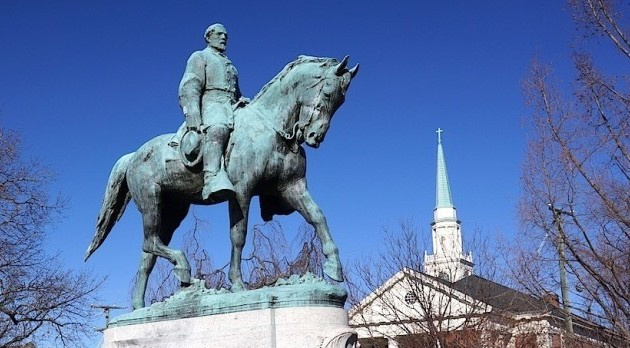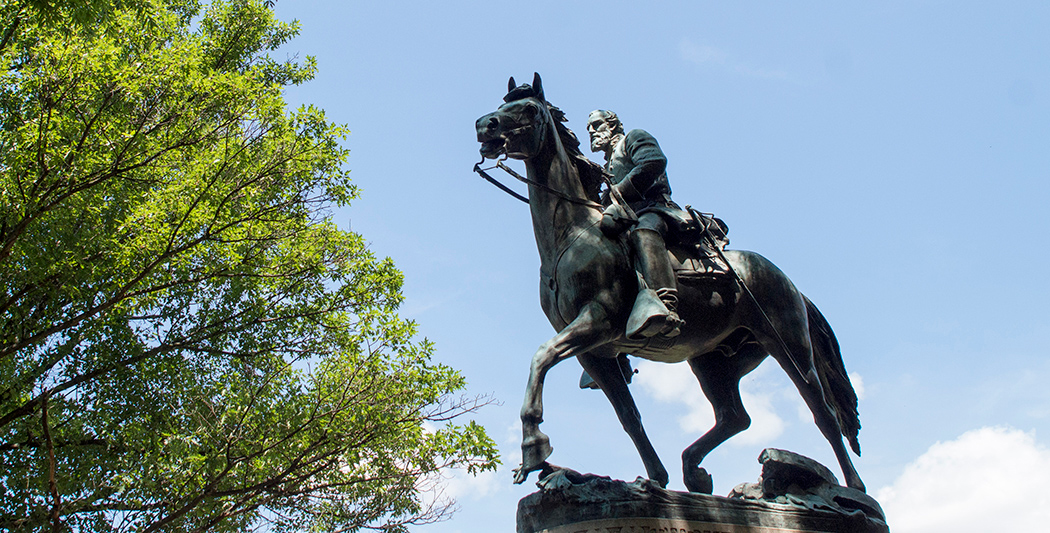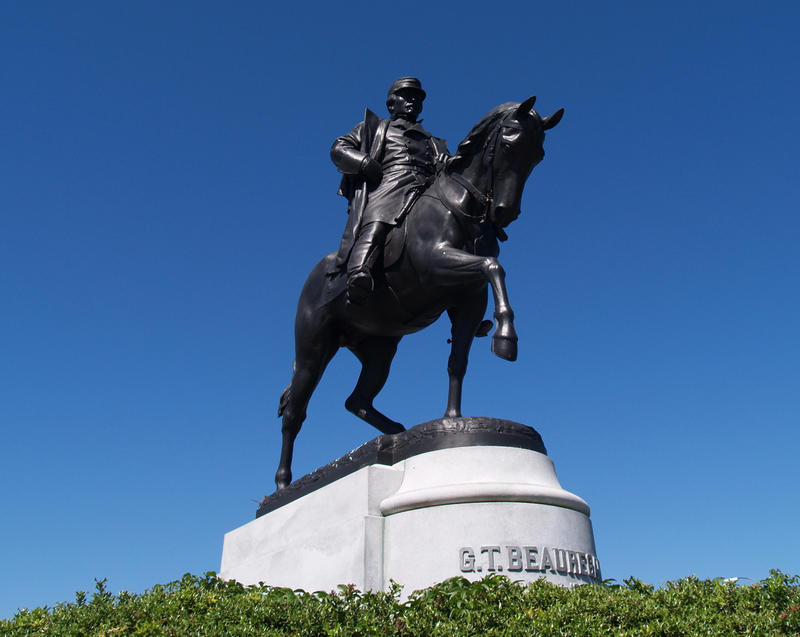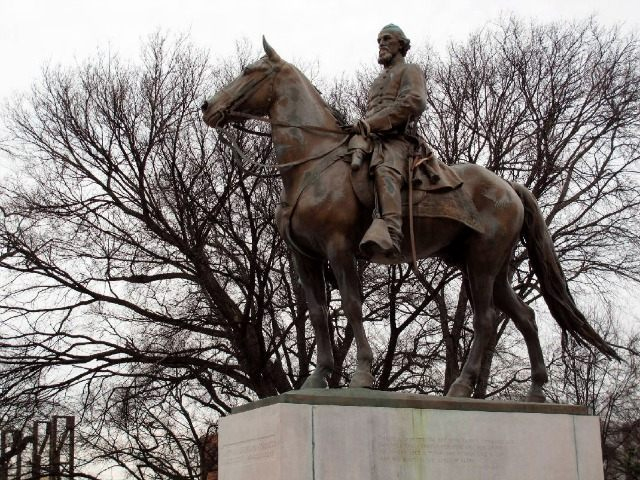
"Note from the Editor: August 14, 2017
In light of the recent events in Charlottesville, we are featuring this article by Patricia Saffran which was originally published several months ago on Feb 21, 2017. "
by Patricia N. Saffran
Some of the most beautiful Beaux Arts equestrian sculptures ever created in North America are now being threatened with removal and obvious damage, many believe, to satisfy the political agendas of certain city councils in the South. Recently, on February 6, 2017, the Honorable Bob Fenwick, one of five on the Charlottesville City Council, VA, cast the deciding vote to remove a multi-ton cast bronze and granite base equestrian statue of Robert E. Lee from Lee Park in downtown Charlottesville.
He declined to comment when asked about the fact that his vote to remove meant certain damage to the statue. The vote was three to two.

There are two Charlottesville monuments in question, of Robert E. Lee mounted on Traveler, 1924 (photo courtesy of drrichswier.com, and of Thomas Jonathan “Stonewall” Jackson on Little Sorrel, 1921. The council voted to remove the Lee statue.
As for the Jackson statue, a compromise proposal put forth by the Honorable Kathy Galvin, to include a sculpture or mural of a Civil Rights leader or other historic character in Jackson park and retain the Jackson statue, was passed unanimously. Both parks would be renamed. The council refused to name a city location where they plan to display the Lee sta)tue after removal or, as reporters speculate, the council will simply warehouse it.
Of course, if those city council members in Charlottesville and around the South would personally guarantee that they will pay for any destruction to any large equestrian statues that they vote to remove, then none of these valuable statues, valued at millions each, would be under threat. An insurance specialist indicated that he would not insure one of the statues in question if it would definitely be damaged.
The debates in the Charlottesvile City Council on the statues and the press do a good job of hiding that two of the sculptors were from New York and were well-known. The council has also not paid attention to the famous horses rendered in these historic statues. The Lee statue was conceived with a plaster maquette by Henry Shrady, who died, and the monument was completed, although altered, by Leo Lentelli, an Italian who immigrated the US.
Shrady is the sculptor of the grand Ulysses S. Grant Memorial at the west front of the Capitol, DC. His father was Grant’s physician as he was dying, a little known fact. Leo Lentelli, who took over the Lee sculpture, went to museums to measure Lee’s uniform and Traveler’s skeleton for accuracy. Traveler was an American Saddlebred.
Traveler’s bones had been preserved after the war due to a great deal of sentiment being attached to them. Lee rode Traveler to surrender to Grant at Appomattox. Charles Keck, the Jackson, and Meriwether Lewis sculptor (elsewhere in Charlottesville,) was Saint-Gaudens’ (the greatest sculptor in America) assistant, and studied in Rome.
Keck observed Virginia riding horses and the local seat for Little Sorrel. Jackson liked to go to sleep on Little Sorrel and the savvy horse knew to keep going wherever he was needed. Little Sorrel was a Morgan, and a descendent of Justin Morgan. After Jackson was killed by friendly fire, Little Sorrel was brought to safety.
He received visitors from everywhere after the war and died at 36. The stuffed Little Sorrel hide still exists and can be visited today at the Virginia Military Institute Museum, Lexington, VA. Besides being precise about their rendering of these Civil War horses, Keck, Shrady and Lentelli were celebrated Beaux Arts sculptors who took commissions for both North and South subjects.
Denying the sculptors’ notoriety seems to be a strategy of the movement around the South to remove various important equestrian monuments.
A number of states have statutes that protect historical monuments. In Virginia, the state law describes war memorials from the past, “if such are erected, it shall be unlawful for the authorities of the locality, or any other person or persons, to disturb or interfere with any monuments or memorials so erected.”
The perplexed Julie Langan, director of the Virginia Department of Historic Resources, commented on how to avoid this statute, “My inclination is to view something like the [General Lee] sculpture in Charlottesville more as a work of art than a Confederate memorial.”
Ms. Langan argues that the National Register of Historic Places describes the Lee monument as having high artistic value, and emphasizes its design and production rather than its association with the Civil War [or perhaps a description of the monument as depicting an important historic Confederate figure was so obvious that it was omitted.]
Will Lyster, a trustee of The Charitable Trust, “Friends of C-Ville Monuments”, which supports “The Monument Fund, Inc,” explains that a lawsuit will be filed over the Lee removal, “We are prepared. We have a team of litigators for the actual filing as well as for the background work and research.
These are very experienced attorneys, one of whom has had a lifetime of municipal litigation. Supporters [for removing the Lee monument] have acted in a very aggressive and agitated manner over the past several months. Each time the opponents of these historic monuments have a protest or come out in public, their actions increase the volume of our donations.
We have had a huge amount of financial support from online donations ever since City Council voted on their resolution.” As to moving the Lee statue, the weight may pose problems. Mr. Lyster explains, “The weight can only be estimated and I don’t know that figure – nor if anyone does. The base is rose granite.
It may be solid through, or it may be a thick veneer around another solid product. Also, I doubt the validity of their ‘over-the-phone’ estimates they received. I believe they are going to be surprised when the true cost of moving comes in closer to $1 million.”
Among black residents of Charlottesville, some expressed distrust of the motive of the town and council leaders who want to take down the Lee statue, that they are intentionally stirring up ill will and it is a new phenomenon. Kenneth Jackson told the City Council, “We [all] grew up together. I used to walk through every neighborhood. Our parents didn’t hate the statue. Don’t play black folks for a fool. This disgusts me – and you’re supposed to be our leaders?”
The impetus to remove Civil War sculptures from downtown has been a talking point for many years and some cities have been shifting sculptures for development and warehousing pieces for some time. As reported in AP articles about recent attempts at sculpture removals, city councils around the South took up the issue in earnest after the Charleston, SC, Emanuel African Methodist Episcopal Church shooting, June 17, 2015.
Apparently, as a reaction to the church incident, on June 23, Governor Nikki Haley, SC, rolled out her prepared agenda to ban Confederate flags in public places. Both the event and the governor’s provoking address served to polarize city councils about physical reminders of the Civil War. Shortly thereafter a number of the city councils decided that streets and buildings should be renamed and that Civil War statuary in their downtowns should be removed, even if it meant leaving their towns bereft of magnificent equestrian art.
The desire to destroy art that represents a sentiment that is foreign to us such as the Lee or Jackson statues may be to some is no reason to remove and damage them. G. Scott Walker, Tourmaster of On Hallowed Ground Tours, Fredericksburg, VA, offers his observations, “The Charlottesville Keck Jackson statue is fabulous - horse in motion ‘plus [something extra.]’
The Lee and Jackson statues have exquisite artistic pedigrees. I oppose blatant moving or removing these Confederate statues. I don’t think that proves or solves much of anything. The renaming issue [for places and streets] - and consulted Rebel issues are impossible for me to relate to, even as a native Virginian.
History is just that: history, but, the situation also becomes one of discontinuing the deification of the Rebel subjects and exploring what they were - human beings. As to Stonewall Jackson, he was an interesting man, admired not only in recent times but also in his own time in Confederate households and in Union and European ones as well.”
Brig. Gen. (Ret.) Parker Hills, author of Art of Commemoration: Vicksburg National Military Park, explains his views on the proposed removals, “We watched in 2001 as the Taliban dynamited the 1,500 year-old Buddhas in Afghanistan.
Even today ISIL continues to destroy ancient and irreplaceable historical art and buildings in Syria, Iraq, and Libya. This destruction is always justified by the perpetrators, who respond that the art offends their religion or sensibilities. Does this sound familiar? Unfortunately, the path of least resistance is the path most often taken.
The right thing to do is always the hardest thing to do.
Our modern cities face many difficult problems, such as poverty, crime, and crumbling infrastructures. However, our elected officials, instead of doing the right thing and tackling these problems, often resort to easier, emotional issues, such as art that some might find offensive. Limited resources are then frittered away with the goal of destruction instead of production.
The result is that the quality of life of the citizens receives no improvement. However, their view of art is forever diminished as they see priceless works either being destroyed or moved to places of obscurity and ultimate destruction. They lose their respect for their art, and that is a tragedy.
Our politicians need to be made to produce and to improve our lives, not diminish them. We need to honor our past--even the parts that we do not embrace--or we will surely forfeit our future.”

photo courtesy of Jason Saul
Besides Charlottesville, statues elsewhere are also under threat of removal. Among the statues the New Orleans mayor requested and City Council voted on to remove is the beautiful General P.G.T. Beauregard equestrian monument by Alexander Doyle, 1915. The sculptor used a Tennessee Walking horse as a model for Beauregard’s mount.
Four historic preservation non-profits immediately filed suit and the case is still pending. The city’s meetings on the removals were highly contentious. The proposed contractors had to remain anonymous in the minutes, but they were known to the public and had already received death threats. Some backed out because of this.
One contractor asked whether the city had schematic drawings of how the statues are attached to their bases. “Without them,” he said, “it would be hard, if not impossible, to remove the statues in such a way as to be absolutely sure they would not break. ”
He added that the Beauregard equestrian monument would definitely be damaged, saying, “It was constructed to be placed, not to be removed. You guys are going to have some damage.” One of the monuments in the lawsuit has already been moved to another location, a smaller funerary piece with a specific racist glorification to The White League.
The fate of the rest, including a standing Lee on a very tall heavy base are still waiting for a legal ruling.

photo courtesy of breitbart.com
Not all communities are willing to spend taxpayers’ money on quixotic lawsuits. An attempt by the Memphis City Council to relocate the 9,500 pound cast bronze statue of Lieutenant-General Nathan Bedford Forrest on one of his favorite horses, King Phillip, 1905, was rejected by The Tennessee Historical Commission. (The base makes the total weight even more.)
The Tennessee Heritage Protection Act of 2013 which “prevents cities or counties from relocating, removing, renaming, or otherwise disturbing war memorials on public properties” was the basis for the rejection of a waiver/application in October 2015.
Even though Forrest is considered controversial for commemoration, as he was a wealthy slaver and First Grand Wizard of the KKK, the statue is first rate. Ohio sculptor Charles H. Niehaus was chosen for the work which took three years to complete, with the casting done in Paris. His style is considered Neo-Classical. King Philip, the actual horse, was a large iron-gray gelding.
Forrest had 29 horses during the war and only King Philip survived. Apparently, King Philip was trained to attack blue uniforms, pining his ears back and charging. After the war, he was known to attack policemen.
Note: The late Professor James Beck’s A Bill of Rights for Works of Art provides the best guidelines for the preservation of historical monuments.
There are more interesting articles in our section on Recreation & Lifestyle.
Are you interested in promoting your business or sharing content on EIE? Contact us at info@equineinfoexchange.com












